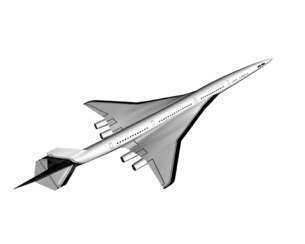High Speed Civil Transport

HSCT conceptual render released on July 1998
The High Speed Civil Transport (HSCT), a supersonic airliner, was the focus of the High-Speed Research (HSR) Program, a NASA program to develop the technology needed to design and build a supersonic transport that would be environmentally acceptable and economically feasible. The aircraft was to be a future supersonic passenger aircraft, baselined to cruise at Mach 2.4,[1]
or more than twice the speed of sound. The project started in 1990 and ended during 1999. The goal was to employ up-to-date technologies.
It was intended to cross the Atlantic or the Pacific Ocean in half the time of a non-supersonic aircraft. It was also intended to be fuel efficient, carry 300 passengers, and to allow customers to buy tickets at a price only slightly higher than those of subsonic aircraft. The goal was to provide sufficient technology for an industry-led product launch decision in 2002, and if a product was launched, a maiden flight within 20 years.
The program was based on the successes and failures of the British/French Concorde and the Russian Tupolev Tu-144, as well as a previous NASA Supersonic Transport (SST) program from the early 1970s (for the latter, see Lockheed L-2000 and Boeing 2707.) While the Concorde and Tu-144 programs both produced production aircraft, neither was produced in sufficient numbers to pay for their development costs.
References
External links
.
|
|---|
| | | Aircraft now withdrawn
from service | |
|---|
| Historic development
projects | |
|---|
| Current development
projects | |
|---|
| | See also | |
|---|
|  Category Category |
|
|
|---|
| | General | |
|---|
| | Military | |
|---|
| | Accidents / incidents | |
|---|
| | Records | |
|---|
| | Misc. | |
|---|
|
.jpg)
